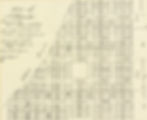The Love-Lost Story of How Noblesville Got Its Name
- hamiltoncomuseum
- Feb 13, 2023
- 4 min read
People will do crazy things for love. When Josiah F. Polk was courting his fiancee In Noblesville in 1823, he didn’t buy a dozen roses or get her name tattooed on his arm. He made an even grander, more lasting gesture to show her that he was the man for her.
Polk was one of the original settlers of the land we now call Noblesville. As reported by historian Augustus Shirts in an 1893 issue of the Hamilton County Democrat, he was a business partner of William Conner, Conner Prairie’s namesake.
Conner knew important people, and as an accidental matchmaker, he introduced Polk to the Noble family of Indianapolis.
As the story goes — and there are skeptical, respected historians who don’t agree with this version of the story — around the same time that Polk and Conner began to lay out their nameless town, Polk brokered two agreements that would impact generations to come.
First, the father of Lavinia Noble agreed to allow Polk to marry his daughter. She was the second youngest of 15 children and only 14 or 15 at the time, so of legal age.
And second, Conner agreed to allow Polk to name the town.
Before Lavinia Noble and Josiah Polk could even make their marriage official, he named the town “Noblesville” after his betrothed.

He also built them a cabin, Noblesvile’s first home according to T.B. Helm’s 1880 History of Hamilton County:
“Mr. Polk was then a single man, but report has it that he was engaged to be married to a Miss Lavinia Noble; and, it is said, he caused vegetables to be sown in his first garden in letters that spelled her name."
But as dramatic demonstrations of love often do, naming the town after her and writing her name in plants did not win over Lavinia Noble enough to get her to the alter, or, as Shirts reported, her family was not impressed enough with Polk to allow him to marry their daughter.
No one knows exactly what led to the split, but we do know that during this time a brother of Miss Noble was mentioned as a possible candidate for the lower house of Congress and her father for governor of Indiana. Shirts seems to lay the blame on the family’s ambitions:
“The Nobles began to put on airs and although Mr. Polk was a good scholar, a good lawyer and a gentleman, the family objected to the marriage so strongly that, notwithstanding the fact that the young lady wished to keep her engagement, she gave way to the importunities of her family, and the wedding was off.”
Eventually, her brother James T. Noble would become a U.S. senator and another brother, Noah Noble, would become governor of Indiana. In his 1915 history, John F. Haines writes that some historians believe Polk named the town after James Noble as a form of flattery. “When the town site was chosen as the county seat and it then was discovered that the young lady had ‘gone back on’ Mr. Polk, perhaps people in general as well as later historians considered Senator Noble a more fitting sponsor for the new town,” Haines wrote.
“Interestingly, there may be a grain of truth to Shirts’ argument,” says Hamilton County Historian David Heighway. “The Nobles became a powerful political family. I could see Josiah Polk trying to make himself part of that political dynasty and getting shown the door.”
There is no historical record of a romance between the couple. No evidence has turned up that Noble did or didn’t want to marry Polk, or if the Noble family disapproved of him for reasons besides their own appetites for success. But one possible reason could have been Polk’s extreme beliefs.
“Polk seems to be anti-immigrant, anti-Catholic, and pro-colonization for free people of color,” Heighway says. As evidence, he shared several articles and a copy of a book Polk wrote that harshly examined the Roman Catholic Church’s religious tolerance.
Polk was a member of the Native American Association of the United States, an organization name that might confuse a modern reader. In the mid-1850s, a “native Amerian” referred to white people who were part of the nativist movement. People like Polk resented immigrants and their impact on the United States. Many nativists demonstrated their beliefs through violence, intimidation and lambasting rhetoric. In an 1839 issue of The Native American, Polk coauthored a call to action:
“Rouse up, then, native Americans! Hitherto you have slumbered in false security. Awake to a sense of your danger. Already the Philistines surround you. Your Delila but caresses to destroy. Awake, ere you be shorn of your strength. The crisis has arrived when you ACT, or expect from your indolence and apathy, to see your Government and country in the hands of foreigners, and yourselves and children the servant of the slaves of Kings!”
One might venture to guess that most young, eligible women — and their families — would find this off-putting, especially a woman like Miss Noble. After rejecting Polk, she married her first husband, Arthur St. Clair Vance, in 1826, and then Wm. H. Hutchison. She survived both her husbands, and six of her children survived her.
In her 1885 obituary in the Indianapolis News, Noble is remembered fondly:
“She was affectionately regarded by a wide circle of friends and her face and many words of kindness were known to many in the neighborhood besides her acquaintances.”
There is no mention of her brief association with Polk. Nowhere does the obituary say how she might have inspired the name “Noblesville.”
But now you’ve learned a theory about how Noblesville got its name and, just perhaps, a lesson in love, too.
The Hamilton County Bicentennial is proudly supported by Duke Energy, Hamilton County Board of Commissioners, Hamilton County Tourism Inc., and Hamilton County Historical Society.
.jpg)






